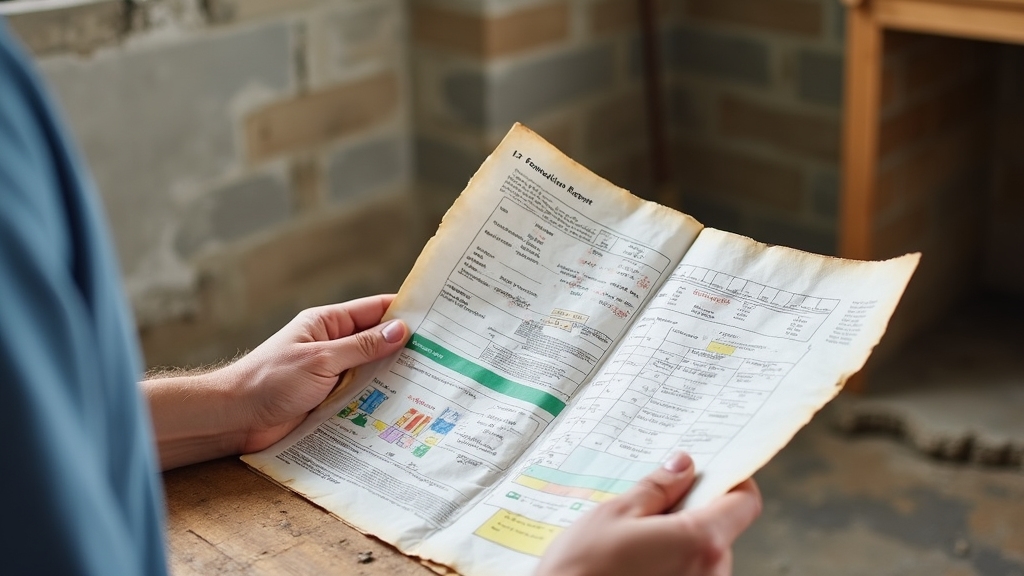Foundation issues in a home can be alarming for any homeowner. Cracks in walls, uneven floors, or doors that stick often signal deeper problems. Understanding the real cause behind these signs is crucial before making repairs or selling your property.
These problems can quickly become costly and stressful if ignored or misunderstood. Misreading a foundation issue might lead to unnecessary expenses or missed negotiations. Many homeowners feel lost when reading a structural report, which can hurt their investment or peace of mind.
The good news is that a structural report can clarify these concerns. A structural report explains your home’s foundation problems and provides expert recommendations for repair or action.
Learning how to read and use these reports empowers you to make smart decisions. This blog will guide you through understanding structural reports and help you protect your home’s value and safety.
Key Takeaways
- A structural report by a licensed engineer assesses the foundation’s current condition, identifying cracks, shifts, or other warning signs.
- The report includes detailed findings, supporting photos or diagrams, and recommended repair methods tailored to the specific foundation issues.
- Structural reports are crucial for real estate transactions, informing buyers, sellers, and lenders about safety, repair needs, and property value impacts.
- Typical repair options suggested in reports include underpinning, waterproofing, and slabjacking, each suited to different foundation problems and severity.
- Early reports and preventative measures help avoid costly repairs, maintain home value, and ensure long-term structural safety.
What Is a Structural Report?

A structural report is a detailed document from a licensed structural engineer. It explains the current state of your building’s foundation. This report is important if you notice cracks or other warning signs. The engineer checks the building and the ground around it. They look for problems that could affect the foundation’s strength.
If there are risks, the report will list them. Understanding foundation integrity and their unique challenges can help prioritize repairs and negotiations during real estate transactions. The report gives clear advice for repairs or ongoing checks. It also helps with real estate sales, insurance, or planning repairs. If you need to make decisions about your property, a structural report gives you expert guidance.
Common Signs of Foundation Issues
You’ll need to watch for specific indicators that suggest foundation concerns, such as cracks in interior walls, uneven or sloping floors, and sticking doors or windows. Recognizing these issues early can help you address problems before they intensify and impact property value. Being aware of foundation assessment techniques can further aid in identifying hidden issues that are not immediately visible.
Cracks in Interior Walls
Cracks in interior walls can show foundation problems in a house. Some small cracks are normal as a home settles. Larger or growing cracks may be a warning sign.
The location and shape of cracks help identify the cause. Diagonal cracks from door or window corners often mean the foundation is settling unevenly. Horizontal cracks along a wall may show serious foundation stress.
Stair-step cracks in brick or block walls often suggest the foundation is moving unevenly. If you see these patterns, you should call a professional. Getting cracks checked early can prevent further damage.
Uneven or Sloping Floors
Uneven or sloping floors can be a sign of a foundation problem. You may see furniture tilting or notice objects rolling to one side. These changes often mean the foundation is shifting or settling.
A professional can measure how much the floor is sloping. Structural reports use these measurements to show if there is a real problem. If the slope is severe, further inspection is needed.
A structural engineer may suggest repairs like underpinning or adding support piers. Fixing these issues quickly can prevent more damage. If left alone, uneven floors can lower your home’s value.
Sticking Doors and Windows
Sticking doors and windows often mean your foundation is moving. These problems usually show your home’s structure is shifting. If you notice this, you should check your foundation soon.
Doors that do not close or latch may be misaligned from foundation changes. Windows that stick when opening or closing can also signal uneven settling. Cracks around frames often appear when the foundation moves.
If you see these signs, act quickly to avoid bigger problems. Early repairs can help keep your home safe and maintain its value. Always consult a professional if you are unsure about foundation issues.
When Should You Get a Structural Report?
You should get a structural report if you see cracks in your walls, uneven floors, or doors that do not close. These signs often mean there could be problems with your home’s foundation. Early checks can help prevent bigger and more costly repairs.
Recognizing market fluctuations and understanding local trends can also influence the timing of your inspection, especially if you’re considering selling your home soon. Additionally, a professional assessment can identify unrealistic pricing issues that might deter potential buyers or lead to financial losses.
Who Can Perform a Structural Assessment?

You need to know who’s qualified to assess your home’s structural integrity. Licensed structural engineers and certified home inspectors each bring specific expertise to the evaluation process. Choosing the right professional ensures accurate diagnosis and compliance with real estate and insurance requirements.
In cases involving termite damage, specialized assessments may be necessary to fully understand the extent of structural compromise. Proper documentation and understanding of marital property laws can also influence the assessment process if ownership issues are involved.
Licensed Structural Engineers
A licensed structural engineer is the right person to check your home’s foundation. This professional has special training and a license to do this work. If you have foundation concerns, you should contact a licensed structural engineer.
These engineers understand soil, building loads, and local codes. They use special tools to find problems like cracks or shifting. Their training lets them spot issues that could affect your home’s safety.
Licensed engineers follow strict state rules and keep up with new standards. Their reports follow all legal requirements. If you need official documents for repairs or sales, you should use a licensed engineer.
Their reports explain what repairs are needed and why. You get clear advice and a plan for fixing issues. If you want reliable answers about your foundation, choose a licensed structural engineer.
Certified Home Inspectors
Certified home inspectors can give you a basic structural assessment. They look for visible signs of foundation problems. These signs include cracks, uneven floors, or moisture entry.
Home inspectors also check the soil around your house and review drainage systems. They may notice issues with gutters, grading, or water flow. If they see a problem, they may suggest repairs or further checks.
Home inspectors do not perform load calculations or detailed soil tests. If you want a full analysis, you should hire a structural engineer. This is important if major foundation movement or soil concerns exist.
What to Expect During the Inspection Process
During the inspection process, a structural engineer will carefully check your home for foundation problems. The goal is to identify any issues and document them clearly. This helps ensure the report is accurate and useful.
The engineer will start with a walkthrough of both the inside and outside of your home. They look for cracks, sticking doors, and signs of water damage. If you have noticed anything unusual, you should mention it.
Special tools help the engineer measure any shifts or uneven areas in the foundation. If there are changes in elevation, these get recorded. The engineer also takes notes and photos for the final report. Understanding the importance of a thorough property evaluation is vital to accurately assessing foundation health.
You may be asked about the home’s history or past repairs. If you have records or details, sharing them can help the engineer. Honest answers can make the report more complete.
It is also important to understand that some foundation issues may require a timely sale or repair, depending on the severity of the problems found. Proper due diligence and accurate documentation are essential steps in the process of resolving foundation concerns.
Key Components of a Structural Report

A structural report explains the state of your home’s foundation. It aims to find problems and suggest clear solutions. If you need repairs, this report shows exactly why and what to do. A structural report highlights your foundation’s condition, pinpointing problems and offering solutions so you know exactly what needs repair.
The report lists issues like cracks or sinking. It uses photos or simple diagrams to show where these problems are found. If the foundation is unsafe, the report recommends fixes like adding supports. Understanding foundation stability is vital for assessing the overall safety of your home.
Moisture problems are also checked, since water can damage foundations. The report tells you if you need changes like better drainage or new gutters. If you follow these tips, you can protect your home’s value.
This report gives you facts to help with repairs or sales. If you plan to sell, it helps meet real estate rules. Each section helps you understand and take action if needed.
Understanding the Findings in Your Report
Your structural report explains the condition of your foundation. It uses specific words and ratings to show how serious any problems are. These details help you understand what repairs or actions may be needed. Additionally, understanding the timing of inspections can influence the assessment accuracy and urgency of repairs.
Timing considerations can impact how quickly a foundation issue is addressed and resolved. Knowing the challenges in selling a home during divorce can also affect decisions about when to schedule inspections and repairs, especially if a sale is imminent.
Typical Foundation Problems Detailed in Reports
In your structural report, you’ll typically see references to common crack patterns and signs of differential settlement. These indicators help you assess the extent and origin of foundation movement that can impact property value and safety.
Recognizing these problems early lets you address marketability and repair costs with confidence. Additionally, understanding which issues are cosmetic flaws versus serious structural concerns can prevent unnecessary repairs and focus your attention on the most critical problems.
Common Crack Patterns
Structural engineers spot foundation issues by looking at crack patterns in your home. They check the cracks’ direction, place, and width. This helps them find possible problems with the foundation.
Vertical cracks often show normal settling or slight soil shifts. These are not always serious but need regular watching. If they widen, you should get them checked.
Diagonal cracks usually appear near doors or windows. These can mean the soil is moving more than normal. Shifting moisture may cause these cracks.
Stair-step cracks form in brick or block walls. These cracks show more severe foundation stress. If you see them, you should act quickly. Knowing these patterns helps you fix problems early. Early repairs protect your home and keep its value.
Differential Settlement Signs
Differential settlement is when parts of a home’s foundation sink at different rates. This often happens due to soil movement or drainage problems. Homeowners should watch for early warning signs.
Stair-step cracks in brick or block walls can show soil is shifting unevenly. Sloping or uneven floors may mean poor drainage or washed-out soil. Sticking doors or window gaps are signs of foundation displacement.
If you notice these problems, take action quickly. Fixing drainage and soil issues early can stop further damage. Professional help is needed to keep your home safe and valuable.
How Structural Reports Affect Home Value
A structural report can change your home’s value. It gives clear details about problems like foundation movement or poor drainage. If issues are found, buyers may offer less for your home.
The report helps buyers understand the home’s condition before they make an offer. If everything is in order, buyers may feel more confident. This can lead to faster sales and better offers.
If the report shows problems, it may lower your home’s value. Buyers will see the repair costs and factor them into their offer. Sellers must share this information to avoid legal trouble later.
Cost of Obtaining a Structural Report
A structural report for a home with foundation concerns usually costs between $500 and $1,500. The price depends on the size of the home, location, and how complex the problem is. This cost should be included in your budget.
If you choose a cheaper report, you may not get a detailed analysis. Experienced engineers often charge more but can spot hidden problems. Their reports also show what repairs are needed.
Always check that the engineer is licensed in your state. Licensed engineers provide more reliable and accurate reports. If you want to avoid future problems, invest in a good report.
Using a Structural Report in Real Estate Transactions
A structural report is important in real estate deals when a home has foundation problems. This report gives a clear picture of the property’s structure. If you have it, you can use it to answer buyer questions and avoid surprises.
The report explains the condition of the foundation, soil, and drainage. Sellers can show this document to be honest about any issues. Buyers can use it to ask for repairs or a lower price if needed.
Lenders and insurers may require the report to check the risk. If the findings are serious, it might affect the loan or insurance terms. The report helps everyone make informed decisions.
Steps to Take After Receiving Your Report
After you get your structural report, read it carefully to see what foundation problems exist. Look for details about soil conditions and water drainage. These issues often cause or worsen foundation movement.
Check that the report’s findings match your own knowledge of the property. If something feels unclear, note your questions for later. Always review any urgent hazards and take safety steps if needed.
Keep your structural report and related engineering documents organized. If you plan repairs, collect bids and check contractor backgrounds. Schedule more inspections if you need more information before choosing a repair plan.
Repair Options Based on Structural Recommendations
Your structural report will outline specific repair techniques, such as underpinning, pier installation, or slabjacking, tailored to your foundation’s condition. You’ll need to weigh the initial costs of each method against their expected durability and long-term value. Making an informed choice here protects your investment and ensures compliance with industry standards.
Common Repair Techniques
Structural reports often show problems with a building’s foundation. Common repair techniques fix these issues and follow expert advice. These methods depend on the damage, soil, and building design.
Foundation reinforcement uses steel piers, helical piles, or concrete underpinning. These tools help to support and steady weak foundations. If the damage is severe, this method is usually needed.
Waterproofing solutions keep water from reaching the foundation. Workers may use sealants, drainage systems, or crack repairs. If water is a problem, these fixes can prevent more harm.
Slabjacking, also called mudjacking, raises sunken concrete by pumping grout under the slab. This levels uneven surfaces and adds strength. If floors are uneven, this method can help.
Choosing the correct repair method protects your property for years. Each technique matches a certain type of issue. Always follow expert advice for the best results.
Cost Versus Longevity
Foundation repair costs can vary depending on the method you choose. Some options are cheaper at first but may not last as long. If you want a long-term solution, you might need to spend more upfront.
Epoxy injections are less expensive but may only last 5 to 10 years. Concrete piers cost more and can last 20 to 30 years. Steel piers are the most expensive but often last over 50 years.
A structural engineer should help you pick the right method for your home. If your soil is weak or your house is heavy, you may need a stronger repair. Always consider how the repair will affect your home’s future value and resale.
Preventing Future Foundation Issues
Preventing future foundation issues starts with simple, proactive steps. Taking care of your home now can stop bigger problems later. These actions protect your home’s stability and keep its value strong.
Moisture control is important for your foundation. You should keep soil moisture steady to avoid soil shifting. This helps prevent cracks or movement in your foundation.
Good drainage keeps water away from your house. If you install French drains or gutter extensions, you can reduce water buildup near the foundation. Less water means less risk of damage.
Regular inspections are helpful. A structural engineer can find small issues before they grow. If problems are found, early fixes can save you money.
If you follow these steps, your home will stay strong for many years. Proper care now gives you peace of mind and protects your investment.
Conclusion
A structural report helps you understand the true condition of your home’s foundation. If you have foundation issues, this report gives clear direction. When you follow expert recommendations, you protect your home’s value and safety.
If you feel overwhelmed by repairs, you have options. We buy houses for cash, even if they have foundation problems. When you need a quick and simple sale, our team can help.
If you want to move forward without stress, let us assist you. We at Limitless Homes of KC are ready to make you a fair cash offer. Contact us today to see how we can help with your property.

